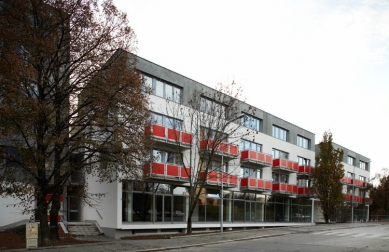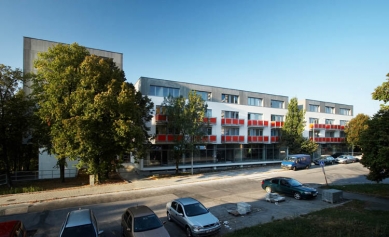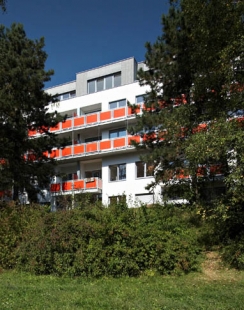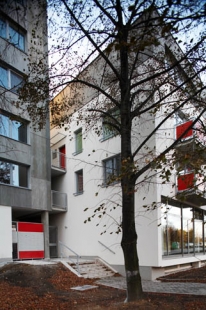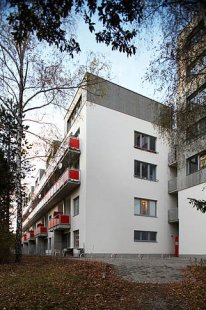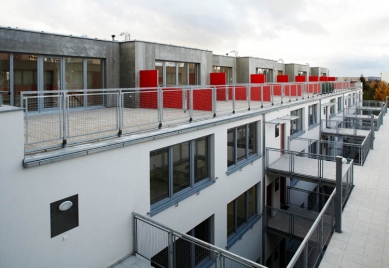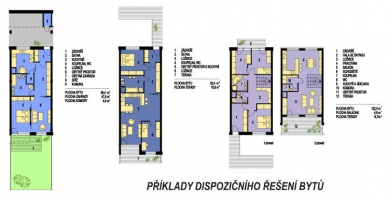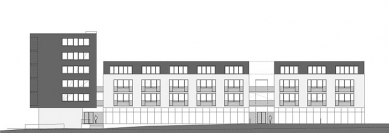
Polyfunctional building Lučina

 |
Between the panel apartment buildings, facilities for civic amenities were set among the greenery. However, as time changed, these facilities lost their functionality and began to remain empty and unused. Shops and other services moved elsewhere. Thus arose the idea to utilize the existing building, preserve the space for commerce, and add residential units.
Unlike the surrounding extensions on panel apartment buildings and the added balconies often referred to among people as "entrepreneurial baroque", the architect chose a stark, clean architecture for the new building. Thanks to this, the house sensitively blends into the existing greenery. The project partially utilized existing load-bearing structures and complemented them with a three-story extension and a six-story annex.
The architectural concept of the design is based on the division of the building into southern and northern sections. These are mutually connected by an open communication gallery, which vertically passes through all proposed floors. The northern section is further divided by excluding one six-meter module into two parts. This solution significantly accentuates the staircase that passes through this space. On the eastern facade, a solitary object of vertical character - the "tower" - is connected to the gallery, which forms a prominent feature from the main approach side. Here is also the main staircase with an elevator connecting all floors.
On the roof of the building, there are new extensions with terraces arranged in a regular grid, belonging to the apartments on the fourth floor. These extensions soften the relatively austere character of the entire building with their rhythm and different material expression.
In designing the volume of the house and the layout solutions for the individual floors, care had to be taken to ensure sufficient sunlight and lighting for the apartment areas.
In the multifunctional building Lučina, 49 apartments and 18 units for integrated housing functions were created. Additionally, on the first above-ground floor of the northern section, there is space for two commercial units. In the basement of the northern section, there is a communal garage with 36 parking spaces, three individual garages in the basement of the annex, and additional parking spaces are provided from the northern and eastern sides of the house. In two floors of the southern wing, utilizing the space of the original building, units for integrated housing functions are located, which also allow for possible barrier-free housing.
In the extensions on the 2nd to 4th floors of the northern and southern sections and the entire space of the newly added tower - 6th floor, a total of 49 apartments were constructed, ranging in size from 42.7 m² to 164.6 m² of floor area. Of this number, 17 apartments are designed as mezzanines, utilizing the space of the 4th floor extensions of the northern and southern sections.
Access to the apartments is from the galleries, which are situated in the atrium between the northern and southern sections, connected to two staircases. Thus, a residential building was created that is unusual in our conditions. Thanks to the gallery with walkways, from where the entrances to the individual apartments are, their residents will certainly meet each other. Moreover, through large windows from their kitchens, which also face into the "atrium", they can see – as they say – right into their plates. The anonymity typical of a classic panel building, where people step out of the elevator and disappear behind doors from a dark hallway, has thus dissipated.
The English translation is powered by AI tool. Switch to Czech to view the original text source.
5 comments
add comment
Subject
Author
Date
?
novotný
03.07.07 12:24
hmm
warrior
15.08.07 04:48
citlivě zapadá?
Olaf
10.01.10 06:39
banální krabice, stokrát vyvařená
Pavel Sojka
11.01.10 10:13
banalismus tradice
Jiri Vitek
11.01.10 12:40
show all comments


